Why you can trust TechRadar
These graphs were produced using data generated by DXO Analyzer.
We shoot a specially designed chart in carefully controlled conditions and the resulting images are analysed using the DXO software.
Signal to noise ratio
A high signal to noise ratio (SNR) indicates a cleaner and better quality image.

JPEG images from the Sony NEX-5n show slightly better signal to noise ratio results than the Sony NEX-5 and the Olympus E-PL3. From a sensitivity of ISO 400 and above the Sony NEX-5n also shows better noise performance than the Panasonic Lumix DMC-G3.
Raw signal to noise ratio

Raw images (after conversion to TIFF) from the Sony NEX-5n shows a better signal to noise ratio across the sensitivity range than the Sony NEX-5 and the Panasonic Lumix DMC-G3 and just beat the Olympus E-PL3 from a sensitivity of ISO 3200.
For a full explanation of what our resolution charts mean, and how to read them please click here to read the full article.
Dynamic range

This chart shows that the Sony NEX-5n's JPEGs capture a wide tonal range across the sensitivity range. Although there is a steep drop from ISO 3200, the tonal separation is still good.
Sign up for breaking news, reviews, opinion, top tech deals, and more.
Raw dynamic range

This chart indicates that the Sony NEX-5n's raw images (after conversion to TIFF) capture a wide tonal range across the sensitivity range, beating the Sony NEX-5, Olympus E-PL3 and Panasonic Lumix DMC-G3 by at least 1ev.
For more more details on how to interpret our test data, check out our full explanation of our noise and dynamic range tests.
Current page: Noise and dynamic range
Prev Page Image quality and resolution Next Page Sample images
When not wrestling wild bears or leaping tall buildings in a single bound, Gavin Stoker can be found editing British Photographic Industry News, the UK's longest running and only photo trade title. He has over 25 years of camera testing and reviewing under his belt.
